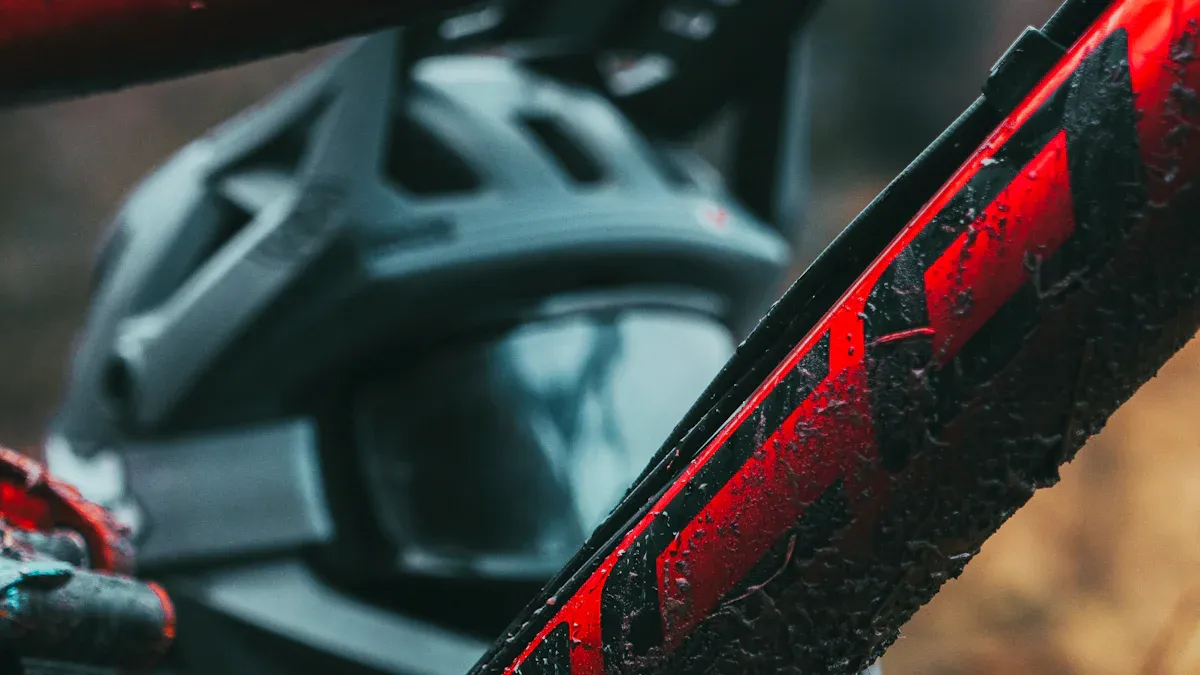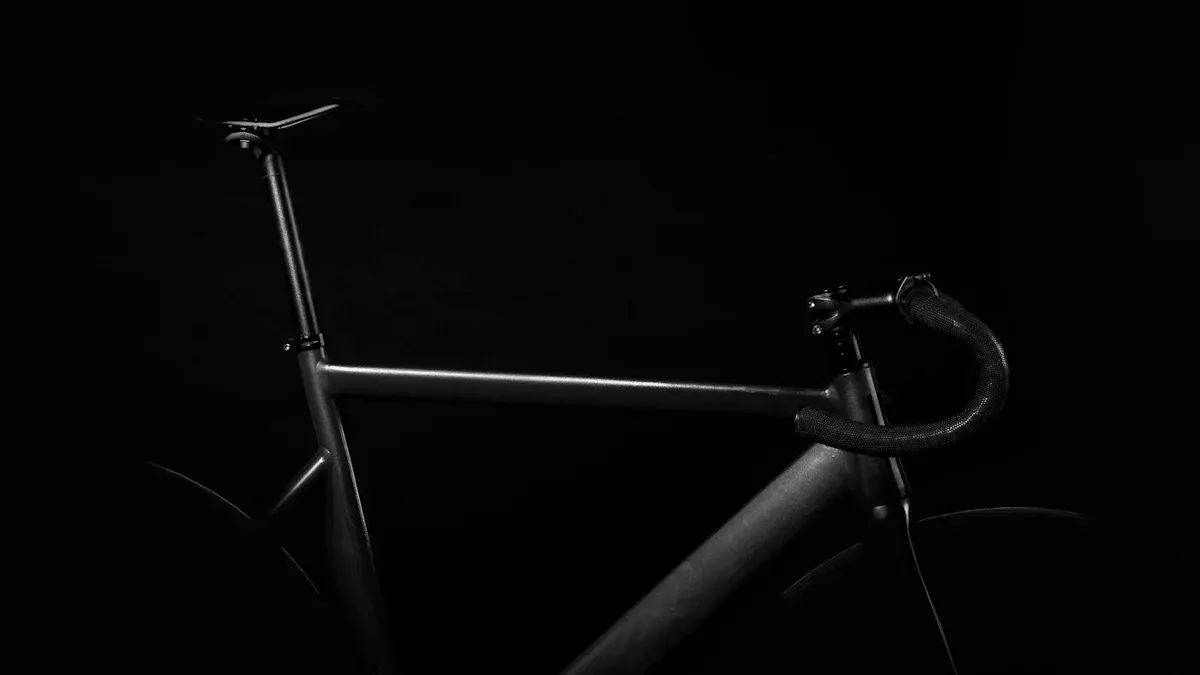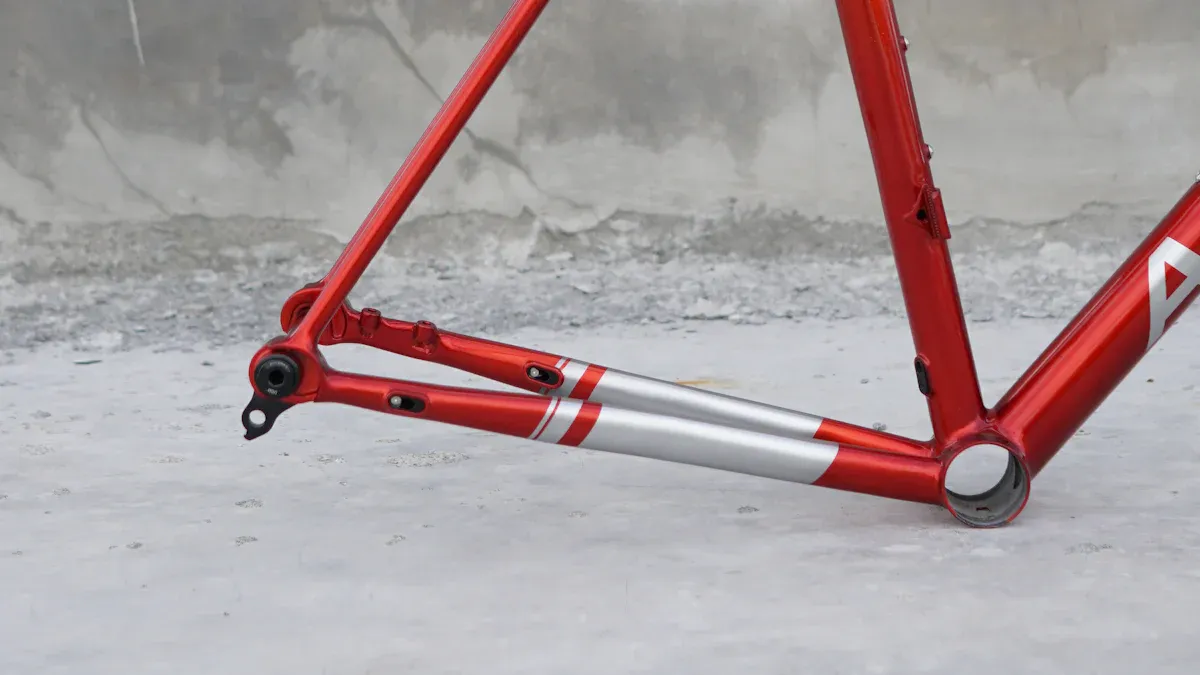
Bike frame parts explained are very important for your ride. Knowing these bike frame parts can help you ride better and safer. For instance, adjusting the saddle height can make you ride easier and use less energy. This helps you perform better and lowers the chance of getting hurt. Value the smart design of your bike. Each part helps your overall ride.
Key Takeaways
Knowing bike frame parts helps you pick the best bike for you.
The frame’s design and material change your bike’s weight, comfort, and performance.
Changing your bike’s fit can improve your ride and lower the chance of injury.
Bike Frame Parts Explained

Top Tube
The top tube connects the front and back of the bike frame. It is very important for keeping the bike stable. A strong top tube can take big hits. This is especially important for mountain bikes. Its triangle shape lets it use lighter materials. This means less extra support is needed. This design makes the bike more stable. You can ride confidently on bumpy paths.
Down Tube
The down tube is the biggest tube in the bike frame. It is key for keeping the bike from twisting. Here are some important jobs of the down tube:
It supports different loads like tension and compression.
A bigger down tube makes the bottom bracket stiffer. This helps pedal force go into the chain better.
This strength makes the down tube important for your bike’s performance. It is especially helpful when climbing or sprinting.
Seat Tube
The seat tube connects the bottom bracket to the seat post. The seat post holds the saddle. This vertical tube supports your weight. It also affects how your bike fits and handles. A good seat tube design makes riding more comfortable and stable. The angle of the seat tube changes your riding posture.
Shallow angles (73 to 74 degrees) put you behind the bottom bracket. This helps your quadriceps and glutes.
Steep angles (75 to 78 degrees) move you forward. This helps those with strong hamstrings and makes you more aerodynamic.
Knowing how the seat tube works helps you ride better.
Chainstays
Chainstays connect the bottom bracket to the rear axle. They are important for transferring power from your pedals to the back wheel. The length of the chainstays changes how the bike handles:
Effect on Bike Handling | |
|---|---|
Longer | More stable, better control on rough trails |
Shorter | More agile, quicker response in handling |
Longer chainstays make the bike stable. Shorter ones make it more agile. This balance is important for different riding styles, whether you like climbing or sprinting.
Seatstays
Seatstays connect the top tube to the rear axle. They help soak up road bumps, making your ride more comfortable. Here’s how seatstays help your biking experience:
Aspect | Description |
|---|---|
Role | Seatstays help absorb road shock and vibration, making your ride more comfortable. |
Material | Usually made of metal (steel or aluminum), some use carbon fiber or titanium. |
Length Influence | Longer seatstays give more flex and shock absorption, leading to a more comfortable ride. |
Design Variation | Shorter seatstays make the ride stiffer, while longer ones are better for rough terrain. |
Average Length | Seatstays are usually between 350mm to 470mm, with an average of about 400mm. |
A good seatstay design can handle compressive forces. This helps the frame last longer. It can also make the bike lighter without losing strength.
Knowing these bike frame parts helps you see how each part affects your comfort, performance, and maintenance. By understanding the top tube, down tube, seat tube, chainstays, and seatstays, you can make smart choices about your bike setup and riding style.
Fork Types and Functions
Rigid Forks
Rigid forks are simple and light. They do not have any springs or shocks. This makes them great for smooth roads. You can find rigid forks on road bikes and some gravel bikes. Here are some good and bad points about rigid forks:
Advantages | Disadvantages | |
|---|---|---|
Rigid Fork | Light, strong, good for fast riding on flat roads | Not good for fast riding on bumpy roads |
Rigid forks give great power transfer. You can feel every push of the pedals. But they do not absorb bumps. This means you will feel every jolt on rough paths.
Suspension Forks
Suspension forks are made to soak up shocks. They make riding more comfy and help you control the bike on rough trails. You will often see them on mountain bikes and gravel bikes. Here’s how they help you ride better:
Suspension forks keep the front wheel on the ground. This gives you better control and less tiredness.
They absorb sudden hits, which helps you stay in control and avoid crashes.
The design of suspension forks can be different. Some have more travel than others, which means they can absorb more shocks. This makes them good for different riding styles. For example, mountain bikes usually have suspension forks with a lot of travel for rough areas.
Primary Function | |
|---|---|
Mountain Bike (MTB) | Made with suspension for rough areas, giving control and comfort. |
Road Bike | Light and stiff for quick handling and good power transfer. |
Gravel Bike | Mixes stiffness and comfort, good for different surfaces. |
Knowing the differences between rigid and suspension forks helps you pick the right bike for you. Each type has special benefits that can make your ride better.
Handlebars and Stem
Handlebar Types
Handlebars are very important for your bike’s comfort and control. Different handlebars fit different riding styles. Here are some common types:
Drop Bars: These handlebars let you change hand positions. They are great for long rides, giving comfort and speed.
Flat Bars: Found on mountain bikes, flat bars give stability and control. They work well on rough paths.
Riser Handlebars: These handlebars lift your hands up, helping you sit upright. This design makes urban riding more comfortable.
Ergonomic Bars: With less drop, these bars offer a comfy hand position. They are good for longer rides.
Aero Bars: Made for speed, these bars help you stay low, cutting down wind resistance.
Wider handlebars give better stability and control, especially on rough paths. They help you steer better in tough spots. On the other hand, narrower handlebars help with speed, which is good for racing.
Stem Functionality
The stem connects your handlebars to the fork’s steerer tube. This connection is key for good steering control. The stem affects your bike’s shape, which changes balance, handling, and comfort. Changing the stem’s length and angle can make your bike steer better and respond faster.
Effect on Rider Position | Effect on Comfort | |
|---|---|---|
Longer Stem | More forward lean | More pressure on wrists and back, not good for long rides |
Shorter Stem | More upright position | Less pressure on back and neck, better for long rides |
Positive Angle | More upright position | Less pressure on back and neck, better comfort |
Negative Angle | More forward lean | Can add pressure on wrists, lower back, and neck |
Knowing the types of handlebars and how the stem works helps you make smart choices. These parts greatly affect your comfort and control while riding.
Bike Frame Materials

When you pick a bike, the frame material is very important for how you ride. Different materials have their own good and bad points. Here are the most common bike frame materials:
Aluminum
Aluminum frames are popular because they are light and strong. In 2024, they make up 35.6% of the market, so many cyclists choose them. Here are some key facts about aluminum:
Lightweight: Aluminum frames are easy to lift, which helps when climbing and sprinting.
Cost-effective: They usually cost less than carbon fiber and titanium.
Stiffness: Aluminum frames can feel stiffer than steel. This stiffness can make the ride rougher. You might feel more bumps during long rides.
However, aluminum frames can get cracks over time, especially at the welds. Fixing them is hard because welding can make the frame weaker. Most repair shops do not suggest fixing big cracks, which might mean you need a new frame.
Material | Cost | Additional Cost Factors |
|---|---|---|
Aluminum | Low | Easy to find and simple to make, so it stays affordable |
Carbon Fiber | High | Hard to make, which raises the price |
Titanium | Very High | Needs special skills and materials, but prices have dropped recently |
Carbon Fiber
Carbon fiber frames are known for being very strong and light. They are getting more popular because of better manufacturing methods. Here’s what you should know:
Lightweight: Carbon fiber parts can be up to 70% lighter than steel or aluminum, helping with speed and climbing.
Strength: This material is five times stronger than steel and twice as strong as aluminum, making it very durable.
Comfort: Carbon fiber absorbs vibrations well, giving you a smoother ride on bumpy roads. It can absorb up to 30% more vibrations than aluminum.
You can shape carbon fiber in many ways, which helps with aerodynamics. This is important for racing. However, carbon fiber can be pricey and may break if damaged.
Steel
Steel has been used for bike frames for a long time. It is still loved for its strength and durability. Here are some benefits of steel frames:
Ride Comfort: Steel frames have a natural springiness that helps absorb bumps, making your ride smooth.
Longevity: Steel lasts a long time and is very strong, often lasting for decades if taken care of.
Repairability: Steel frames are easier to fix than aluminum ones, making them a good choice for many riders.
Today’s steel frames often use air-hardened steel. This allows for welding without hurting the material’s strength. This change has led to more custom steel bikes being made.
Material | Ride Comfort | Longevity |
|---|---|---|
Steel | Natural springiness absorbs bumps, leading to a smooth ride. | Very strong, can last for decades with care. |
Aluminum | Rougher ride, less ability to absorb bumps. | Light but may not last as long. |
Carbon Fiber | Can be adjusted for comfort, may be stiff or soft. | Can break under pressure, lifespan varies. |
Knowing about these bike frame materials helps you make smart choices for your bike. Each material affects how your bike performs, its weight, and how comfortable it is. Choose carefully based on how you like to ride.
Understanding bike frame parts is important for all bike lovers. Here are some main points:
Knowing bike frame parts helps you choose the best bike.
Frame shape affects how stable and responsive the bike is.
The materials change how heavy the bike feels.
A good fit makes riding more comfortable and easier to control.
Different frame shapes can change your speed and comfort.
Look closely at your bike and think about how each part helps your ride. This knowledge will help you make smart choices about upgrades and repairs, leading to a better ride.
FAQ
What is the most important part of a bike frame?
The down tube is very important. It keeps the bike stable and supports its structure.
How does frame material affect my ride?
Different materials change the bike’s weight, comfort, and how long it lasts. Pick one that fits your riding style and likes.
Can I upgrade my bike frame?
Yes, you can upgrade your bike frame. Think about your riding needs and budget before making changes.
See Also
Understanding Bike Frame Components And Their Key Functions
Key Components Of Bike Frames And Their Operational Roles
Essential Bike Frame Parts Cyclists Must Be Aware Of
Differences Between Fat Bike Frames And Mountain Bike Frames
How Foldable Bike Frames Operate And Their Collapsing Mechanism
